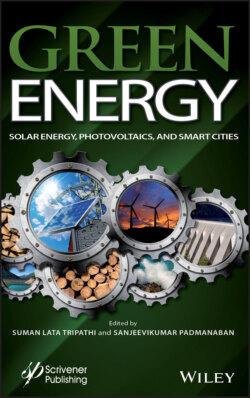Читать книгу Green Energy - Группа авторов - Страница 13
1.1 Introduction
ОглавлениеThere has always been a surge to discover newer sources of energy which can be effective alternatives for the orthodox sources of energy, such as, petrol, kerosene, wind energy, thermal power generators [1,2]. In this quest, the sun is a natural huge source of renewable green energy. It is noteworthy that the terrestrial soil is exposed to an enormous amount of solar energy as large as about ten thousand times of all the energy used around the globe. The terrestrial hemisphere facing the sun receives power in excess of 50,000 terawatt (TW) in each instance, which makes reception of an enormous amount of energy possible [3]. Photovoltaics (PV) technology is a technology that relies on this infinite source of sunlight and possesses inherent qualities of highly reduced service costs since the sun provides free energy, reliability, noiseless, minimum maintenance costs and readily installation features [4, 5].
As a matter of fact, thermonuclear fusion reactions happen non-stop at a temperature of millions of degrees to generate huge energy in the form of electromagnetic radiation of sunlight [5,6]. The outer layer of the earth’s atmosphere receives partial energy of the total energy from the sun with a solar constant or an average irradiance of approximately 1367 Wm-2 with a variation of ±3% [8]. This value of solar constant is dependent on the earth-to-sun distance and on the solar activity. The solar constant is defined as the intensity of solar electromagnetic radiation impinging on a unit surface area and is expressed in units of kWm-2 and is equal to the integral of the power of the individual frequencies in the spectrum of solar radiation. The geometry of the sun-to-earth distance is displayed in Figure 1.1 given below.
Solar irradiation is the integral of solar irradiance over a particular period of time depicted by kWhm-2 and the radiation falling on the surface of the earth is actually diffuse radiation [8]. Diffuse radiation is that part of light radiation striking the surface from whole of the sky, while other radiations are the part reflected from the ground, and by surrounding atmosphere. Different types of radiation received by a solar panel [9] are displayed in Figure 1.2 as shown below.
